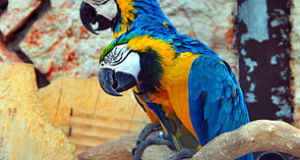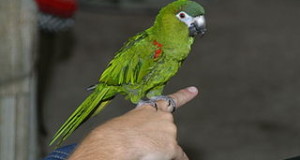The term “bumblefoot” is often applied to a variety of un-related ailments. In actuality, however, it is a very specific medical condition that strikes the underside (or plantar surface) of the foot.
Causes
 A number of factors, including poor nutrition and trauma, may contribute to the development of bumblefoot. However, inappropriate perches or, in the case of quail, waterfowl, pheasants and other ground-dwellers, rough substrates, are the usual culprits. I have rarely if ever come across bumblefoot among wild birds or those housed in huge zoo exhibits with a variety of perches. It is only when birds are forced to perch or walk upon certain substrates that the condition becomes common.
A number of factors, including poor nutrition and trauma, may contribute to the development of bumblefoot. However, inappropriate perches or, in the case of quail, waterfowl, pheasants and other ground-dwellers, rough substrates, are the usual culprits. I have rarely if ever come across bumblefoot among wild birds or those housed in huge zoo exhibits with a variety of perches. It is only when birds are forced to perch or walk upon certain substrates that the condition becomes common.
Diagnosis and Prevention
Bumblefoot first manifests itself as redness or swelling on the bottom of the feet. If left untreated, abscesses develop and opportunistic bacteria take hold. Eventually, the bacterial infection may spread to the bone, at which point amputation may be the only recourse.
As afflicted birds may not limp or otherwise evidence discomfort for some time, it is important that you check your pets’ feet regularly, especially if they are house in small cages with a limited variety of perches.
Prevention is simple – you must research the particular perching or substrate needs of each species that you keep. This varies greatly among different types of birds – please bear in mind that the perches provided with a cage may not be suitable (in terms of width and composition) for the species you intend to house there.
Further Reading
Perch selection is not quite as simple as it may first appear. To learn more, please see my article Choosing the Proper Perches for Pet Birds.
Image referenced from Wikipedia and orignally posted by snowmanradio.
 That Bird Blog – Bird Care and History for Pet Birds
That Bird Blog – Bird Care and History for Pet Birds




What is the treatment for bumblefoot and diet.
Hello Lissette, Frank Indiviglio here.
Thanks for your interest in our blog.
If the condition has advanced to the point where the bird is limping, or the foot appears red or swollen, you’ll need to seek veterinary assistance. If left untreated, a potentially fatal infection is likely.
A proper diet is always a must, although perch width and substrate composition are directly involved in bumblefoot as well. Please let me know what species of bird you are keeping if you need advice concerning proper nutrition.
Good luck and please keep me posted.
Best regards, Frank Indiviglio.